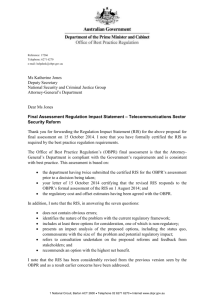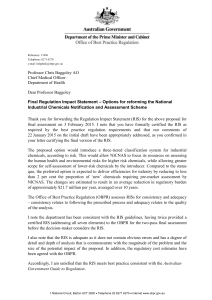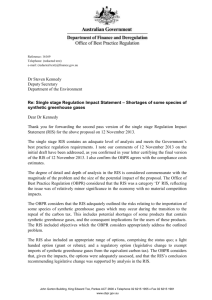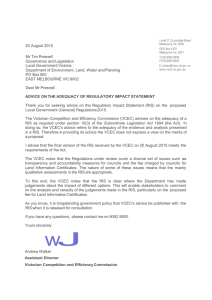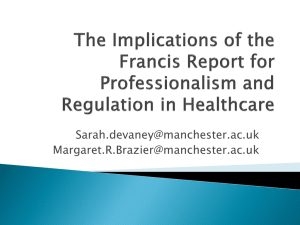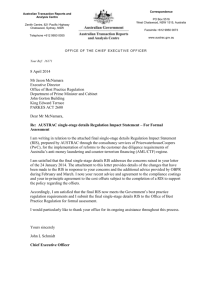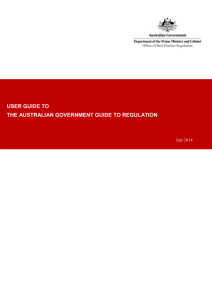Amendments to ASIC Derivative Transaction Rules (Reporting) 2013
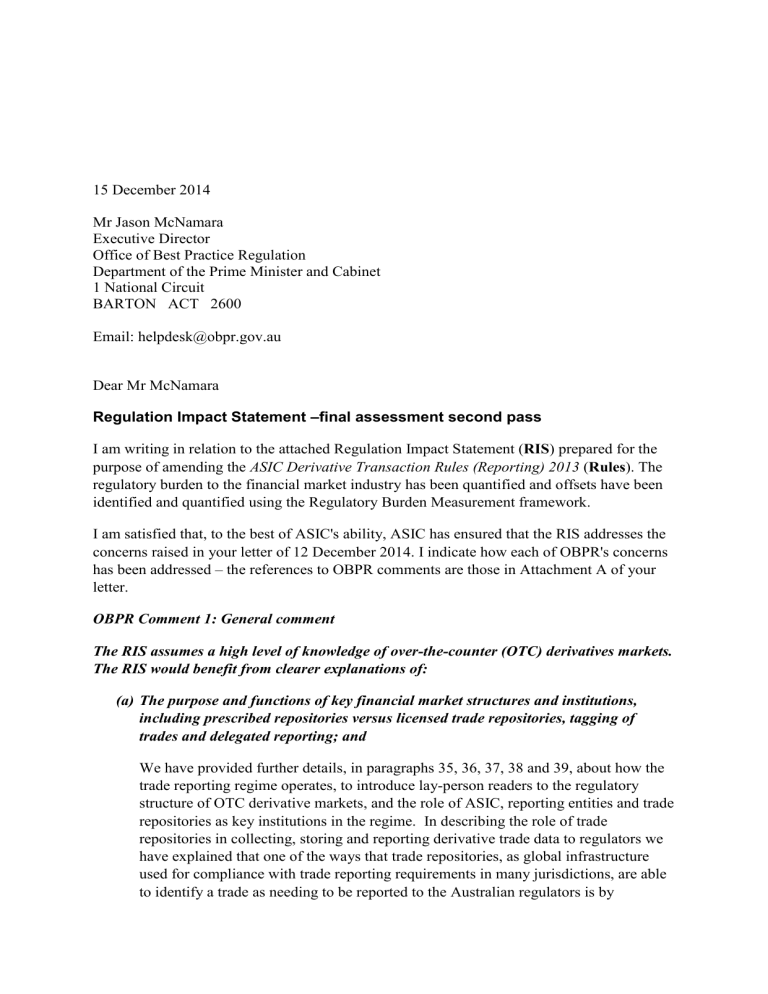
15 December 2014
Mr Jason McNamara
Executive Director
Office of Best Practice Regulation
Department of the Prime Minister and Cabinet
1 National Circuit
BARTON ACT 2600
Email: helpdesk@obpr.gov.au
Dear Mr McNamara
Regulation Impact Statement –final assessment second pass
I am writing in relation to the attached Regulation Impact Statement ( RIS ) prepared for the purpose of amending the ASIC Derivative Transaction Rules (Reporting) 2013 ( Rules ). The regulatory burden to the financial market industry has been quantified and offsets have been identified and quantified using the Regulatory Burden Measurement framework.
I am satisfied that, to the best of ASIC's ability, ASIC has ensured that the RIS addresses the concerns raised in your letter of 12 December 2014. I indicate how each of OBPR's concerns has been addressed – the references to OBPR comments are those in Attachment A of your letter.
OBPR Comment 1: General comment
The RIS assumes a high level of knowledge of over-the-counter (OTC) derivatives markets.
The RIS would benefit from clearer explanations of:
(a) The purpose and functions of key financial market structures and institutions, including prescribed repositories versus licensed trade repositories, tagging of trades and delegated reporting; and
We have provided further details, in paragraphs 35, 36, 37, 38 and 39, about how the trade reporting regime operates, to introduce lay-person readers to the regulatory structure of OTC derivative markets, and the role of ASIC, reporting entities and trade repositories as key institutions in the regime. In describing the role of trade repositories in collecting, storing and reporting derivative trade data to regulators we have explained that one of the ways that trade repositories, as global infrastructure used for compliance with trade reporting requirements in many jurisdictions, are able to identify a trade as needing to be reported to the Australian regulators is by
reporting entities nominating (or 'tagging)' trades as relevant to Australia. We have also explained the operation of, and our proposed changes to, delegated reporting.
(b) Industry-specific terms, including: 'exchange-traded derivative', 'nexus trades',
'safe harbour' and 'one-sided reporting'.
We have explained the meaning of 'exchange-traded derivative' at paragraph 140,
'nexus trades' at paragraph 105, 'safe harbour' at paragraph 150 and 154, and 'singlesided reporting' at paragraph 157. We have defined various other terms throughout the paper.
OBPR Comment 2: What is the problem you are addressing?
Based on our discussions we understand the three broad categories of risk are:
(i) The build-up of risk within systemically important entities;
(ii) Potential market manipulation resulting from OTC derivative traders taking advantage of market-sensitive information; and
(iii) A broader lack of market transparency relating to a potential source of corporate control.
(a) The RIS should include a brief assessment of the seriousness of these risks in the
Australian context; draw a clear link to the specific deregulatory measures identified in the RIS; and discuss how the proposed changes are likely to impact on the ability of the overall policy framework to address these risks.
The key objective of the OTC derivative trade reporting regime was to address risks caused by a lack of transparency in OTC derivative markets. We have set out, in paragraphs 43, 44, 45 and 46, an explanation of how a lack of market transparency is a serious risk for international financial markets and regulators. That discussion touches on the need for regulators to have adequate information to make informed decisions in times of market disruption or manipulation.
The build-up of risk within systemically important entities is indeed an important issue in the broader OTC derivative reform agenda, but is the focus of another branch of the reform – mandatory clearing, rather than mandatory trade reporting. However information obtained under the Rules will allow regulators to better identify and monitor build-up of systemic risk and their sources.
We have also drawn clear links from each specific Rule amendment mentioned in the
RIS to the overarching objectives of the G20 reform in paragraphs 110, 122, 131, 144,
168, 176 and 192.
OBPR Comment 3: What is the problem you are addressing?
The problem section should include more analysis of how the Rules currently fail to achieve the intended policy outcomes, particularly in relation to disproportionate compliance costs and gaps in reporting.
(a) This discussion should be supported by evidence or, in the absence of evidence, an assessment of the likelihood that these issues will eventuate.
In our analysis of each Rule amendment in Section D, we had sought to explain the current obligations under the Rules and need (or problem addressed) for each proposed Rule change. In Section D, we have also analysed how each Rule amendment will advance the intended policy outcomes of reducing disproportionate compliance costs and reduce gaps in trade reporting data. To address OBPR's concern, we have provided further context and clearly drawn out the problem addressed by each Rule amendment in paragraphs 50, 51 and 52.
OBPR Comment 4: What policy options are you considering?
The RIS should include enough information to allow a reader to adequately understand each option and how these relate to the identified categories of risk. For example:
(a) Tagging trades: Under what circumstances are trades required to be tagged? How is this different to numerical identifiers? How will Australian regulators access tagging data?
Tagging trades is an important mechanism to facilitate trade reporting to the
Australian regulators in the circumstances where foreign reporting entities use the alternative reporting exception under the Rules - additional information on the alternative reporting regime is included at paragraphs 174 - 182. We explain in detail, at paragraphs 99 and 100, how certain trade repositories use tagging as a mechanism to identify which OTC derivative transactions should be sent to which regulator. We also briefly explain alternative reporting and why tagging is required when alternative reporting is used.
(b) Snapshot reporting: Does snapshot reporting relate to new OTC contracts or movements in the reference asset price? Why is daily reporting necessary? How does this address the identified market risk and how does it relate to comparable market oversight regimes aimed at preventing build-up of systemic risk?
Snapshot reporting requires daily reporting for all open positions for OTC contracts.
In contrast, lifecycle reporting requires each separate modification, entry and close of a transaction to be reported throughout a day. Most types of OTC derivatives are medium to long term contracts (from several days to several years) and are not opened and closed in one day. Daily snapshot reporting (rather than less frequently, for example weekly) is necessary to allow regulators to detect and investigate trading trends, analyse whether there is a build-up of systemic risk, and supports the G20 objective of enhanced transaction transparency. This is also consistent with the approach taken in some other G20 jurisdictions, and so has similarly been determined
in those jurisdictions as being necessary to ensure they meet their G20 objectives. We explain this in further detail at paragraphs 131 and 133.
(c) Delegated reporting: What is the relationship between a delegate and delegator?
How does reporting to a delegate reduce the compliance burden for the delegator?
The relationship between a delegate and a delegator will depend on the terms of privately negotiated delegation agreements. However the liability arrangement is set under the Rules. Under the existing Rules, if a reporting entity delegates its reporting obligation it remains responsible for its reporting obligations. With the proposed delegated reporting safe harbour, the liability arrangement will change such that a reporting entity will be deemed to have met its reporting obligations if it meets certain conditions. We explain the arrangements under the new safe harbour delegated reporting option and the reduction in compliance burden in further detail at paragraphs 150, 151, 152, and 153.
(d) Overseas equivalence and regulated foreign exchanges: How does the overseas equivalence regime facilitate domestic regulatory oversight?
Domestic regulatory oversight through deference to equivalent overseas regimes has been supported by the G20. Deference to substantially equivalent overseas regimes is where international regulators recognise that although overseas rules may differ in detail, the overall outcome of the requirements in different jurisdictions is the same – i.e. international regulators look to the substance and policy objectives of equivalent overseas regimes. In order for the Australian regulators to receive information about trades reporting under overseas regimes, it is therefore critical that reporting entities be required to tag their trades as relevant to Australia. We explain how allowing alternative reporting under substantially equivalent overseas regimes facilitates domestic regulatory oversight in further detail at parapraphs175 and 176.
OBPR Comment 5: Why is Government action needed?
The objective should be framed to support a range of policy options. The current objective pre-justifies the preferred option.
(a) A broader policy objective might include: enabling Australian financial regulators to collect adequate information to facilitate appropriate and timely regulatory oversight, while minimising compliance costs for industry.
The OTC derivative trade reporting reform is primarily informed by the objectives which were set by the G20 at the Pittsburgh Summit in 2009. In support of those primary objectives, there is a broader policy objective of ensuring that the implementation of the Rules is balanced to enable to Australian regulators to meet the
G20 objectives of these reforms, while at the same time avoiding unnecessary compliance costs for industry. We have included a statement to that effect in paragraph 34.
OBPR Comment 6: What is the likely net benefit of each option?
The RIS as currently drafted focusses heavily on the regulatory burden impacts, almost to the exclusion of broader impact analysis.
(a) Each of the identified options should include an impact assessment, including with reference to how each reform will impact on the risks identified in the problem section.
We have broadened the impact analysis of Option1 in paragraphs 64 and 65.
Similarly, we have broadened the impact analysis of Option 3 in paragraphs 79, 80 and 81.
Our experience since the implementation of the Rules is that industry is most concerned with the costs involved in implementation. Given the Rules were finalised quite recently in order to meet the G20 objectives, this round of rule changes (in particular Option 2) were made with the key goal of identifying unnecessary burdens on industry and where they could be removed while still allowing the Australian regulators to meet their G20 objectives. Therefore ensuring the regulatory burden was minimised was the most important goal of these reforms.
OBPR Comment 7: What is the likely net benefit of each option?
Option 3 currently does not include a regulatory burden estimate. Regulatory burden estimates are required for every viable option.
(a) The regulatory burden, and key assumptions underpinning the estimate, should be included in the impact analysis for Option 3.
We have estimated the financial impact of implementing Option 3 Based on assumptions included in the RIS, we estimate the overall industry cost of implementing Option 3 would be $2.3 million per year. We outline our assumptions and calculations in paragraph
84, 85, 86 and 87, and summarise the overall cost imposition of Option 3 in Table 10.
I am satisfied that the RIS now meets best practice consistent with the Australian
Government Guide to Regulation .
I submit the RIS to the Office of Best Practice Regulation for formal final assessment.
Yours sincerely
Oliver Harvey
Senior Executive Leader, Financial Market Infrastructure
Australian Securities and Investments Commission
